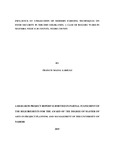| dc.description.abstract | The agriculture sector is the backbone of Kenya’s economy and a means of livelihood for most of the population. The achievement of national food security is a key objective of the agricultural sector. Food availability, according to the Kenya National Food and Nutritional policy (2011), has over time been understood in terms of cereals surplus and food security in terms of having enough maize. Food and Agriculture Organization (2000) referred maize as the staple food for Kenya, averaging 80% of the total cereals produced. The demand for maize is growing and is expected to double by 2050 (Rosegrant et al. 2007). This study examined the influence of utilizing modern farming techniques on maize yields as way of addressing food insecurity in Ruguru ward and in the dry highlands in general. The objectives of the study were to examine how the use of early maturing crop varieties influences maize yields in Ruguru ward, to establish the extent to which the use of fertilizer influences maize yields in Ruguru ward, to establish how water harvesting influences maize yields in Ruguru ward and to determine how training affects maize yields in Ruguru ward. The study used a descriptive survey design. A sample of 250 respondents, from 9,133 households, was considered. Questionnaires were used to collect data. Data analysis was done using Statistical Package for Social Sciences and Ms Excel. Descriptive statistic was done and data presented using frequency tables. In the first objective, the study showed that 53.9% of the respondents used early maturing maize varieties (2-3 months) with a fairly good yield of seven 90kg bags per acre. Though the average maize yields obtained from this study were lower than the optimal maize yields, the early maturing maize varieties gave 2 bags (29%) more than the moderate maturing maize varieties, and 3 bags (43%) more than the long maturing maize varieties. In the second objective, 93.9% of the respondents used manure, inorganic fertilizer or both for maize production. 47.4% of the respondents used inorganic fertilizer only obtaining an average of 6 bags per acre. 16.7% of the respondents used manure and fertilizer getting an average of 8 bags per acre. The respondents who used manure only obtained 3 bags (75%) more than those who used nothing, those respondents who used fertilizer only got 5 bags (83%) more than those who used nothing, and respondents who used a combination of manure and fertilizer obtained 7 bags (88%) more than those who used nothing. On water harvesting, 61.4% of the respondents used terraces and grass strips, which were not sufficient for their maize production as was evident from the observed lower actual maize yields (7 bags per acre) in relation the expected maximum yields (16 bags per acre) while using early maturing maize varieties. On training, 73.2% of the respondents had obtained trainings on maize production mainly from government extension staff. This led to improved use of production practices aimed at improving crop yields and food security at the household level. For instance 93.9% of the respondents used manure and or fertilizer and got 4-8 bags of maize acre compared to 1 bag for those who used no fertilizers. The resulting maize yield difference of between 75% and 87.5% is an indicator of informed farmers able to make fairly good production decisions. Thus technologies utilized by the respondents promote good yields in an area experiencing light and unevenly distributed rainfall for 66.7% respondents. From the study it is recommended that the government and stakeholders do the following: increase the supply of subsidized fertilizers, support water harvesting and community irrigation schemes, offer more training on maize agronomy and related aspects to the farmers. Individual farmers, in the dry highlands, encouraged to adopt modern farming techniques for improved food security. | en_US |

